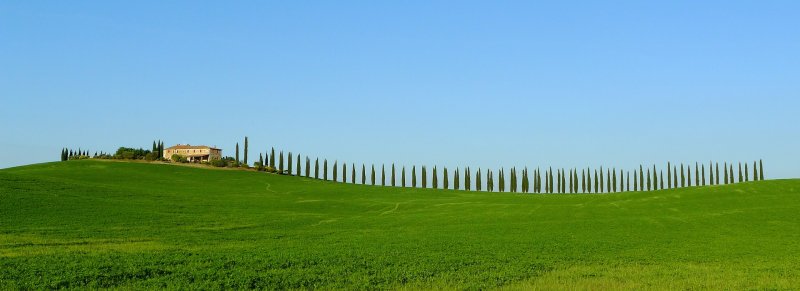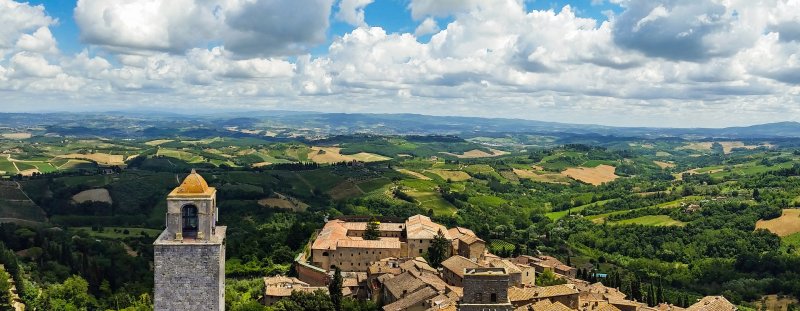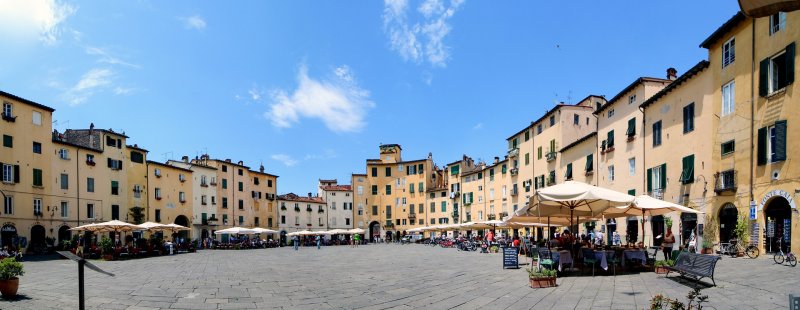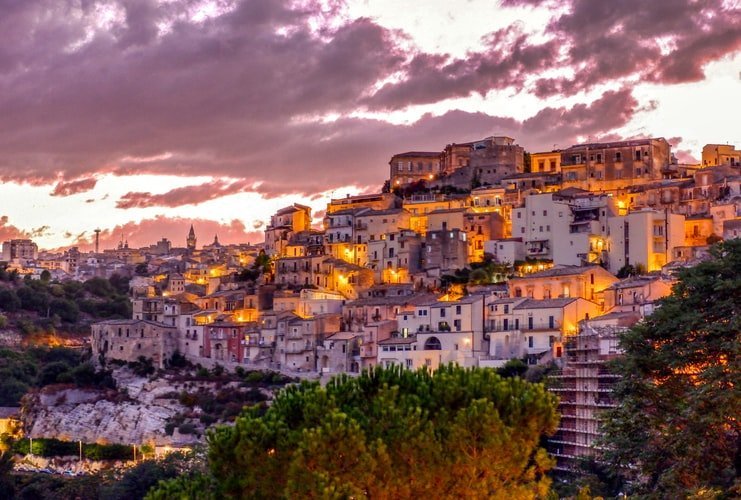A backpacker-style itinerary to discover one of the most popular regions of Italy, while staying, of course, at some of the best Tuscan hostels.
The fact that Tuscany is one of the most loved regions in Italy is certainly not a mystery: for years it has been one of the top destinations for foreign tourists passing through the country, particularly appreciated by Germans, French, Americans and Brits, and in recent years, also by the Chinese (with about one million visiting annually, given the constant growth). On the other hand, we are talking about a region that combines art, culture, history, excellent gastronomy and enchanting natural landscapes in a way that few other places know how.
"Tuscany is a magical landscape where everything around is kind, everything is old and new" - Curzio Malaparte
In this article we propose a circular itinerary which passes through enchanted hills (the boom of likes on your Instagram profile is guaranteed!) and historic villages where life seems to have remained still. All this while staying in 8 beautiful hostels in Tuscany: a selection of different properties, all of them special and characterized by a good quality/price ratio and a unique social atmoshpere. They are the ideal places to stay to fall even more in love with this beautiful region.

WHERE TO START: THE HILLS TO THE SOUTH OF FLORENCE
The backpackers style tour of Tuscany starts from the beautiful hills south of Florence, where you can count on the warm hospitality of the Spedale del Bigallo. It is an old building that has been home to travelers and pilgrims since the thirteenth century, and has now been converted into a modern hostel that maintains its medieval atmosphere, but is equipped with all modern comforts at the same time. It has both private rooms and charming dormitories with a total capacity of 52 people. The Bigallo hostel allows you to stay in a spectacular natural setting, surrounded by the silence of the hills and the green of the olive groves and with a panoramic view of the city of Florence (it is located in Bagno a Ripoli and the center of Florence can be reached by car or by bus in about ten minutes). it is also a meeting place, where you can feel at home, meet new friends and participate in events and activities organized by the staff (every evening at 8pm there is "Pasta Time" where you can enjoy a steaming and excellent spaghetti dish and glass of local red wine for €7, an excellent excuse to sit down and socialize with other travelers). It is worth planning a trip out of Bigallo to the countryside of Mugello, or in the area of Fiesole (ou can also rent a bike from the hostel).

Photo from the garden of Ostello del Bigallo
FEAST YOUR EYES IN VAL DI PESA
To get to the second stage of the tour we need to proceed south and enter the Val di Pesa and the areas where Chianti is produced, a true world excellence in Italian wine production. There will certainly be occasions for a toast. It is advisable to take a slight detour to Casciano Val di Pesa to climb the Torre dell'Acqua, also known as the Torre panoramica del Chianti. From here you can enjoy a truly breathtaking 360° view and take some spectacular pictures, especially at sunset.

photo of the Torre dell'Acqua from the Instagram of veruska.ferrara26
ENJOY AND EXPLORE THE CHIANTI REGION
Go further south again and with a little detour you can pass through the Antinori in Chianti classic winery. A formidable place where the quiet stillness of the hills and vineyards meets the modern architecture in this avant-garde building. A place that blends with great harmony a tradition that dates back to the 14th century and an innovation that even today makes the wines of this ancient family one of the most surprising in the area. This unique winery was inaugurated in 2012 and is built entirely with local materials and with particular respect for the environment and the surrounding Tuscan landscape. It was designed to welcome wine fans from all over the world, as well as to share the passion of those who produce wine in this area, without ever compromising on quality.

Photo of the Cantina Antinori in Chianti classico from the website antinori.it
Continuing to go south you will arrive at Tavarnelle Val di Pesa where there is the second strategic base of this tour: the Chianti Hostel. Strategic is the correct word, given that the location is in the heart of the Chianti region and there are really a lot of excursions and activities that can be easily reached from here: hills, fields, woods, olive groves, vineyards, villas, castles and ancient villages, as in the classical landscape of a 14th century Sienese painting. The Chianti hostel has a maximum capacity of 82 beds (double, quadruple and six-bed) and is therefore ideal for those traveling in groups or with family. The selling point of the property is the peaceful garden where you can relax at the end of the day. There is also a restaurant and a large private parking for guests.

Photo of the lush chianti countryside
TUSCANY UNDER THE STARS
We can now head towards San Donato in Poggio where planning a little detour from the itinerary to visit the Multifunctional Observatory of Chianti is really worthwhile. The 'OPC' is located in a quiet botanical park (light pollution is not a problem here!) and, thanks to its super powerful telescope with a diameter of 80 centimeters, it's a place of great interest for astronomical observations. Luckily, the 'OPC' is not only a scientific site but rather it aims to be a place of social aggregation and a center of cultural growth - exhibitions, conferences, events and themed dinners are organised here. It's not always open to the public, but it is possible to visit it on some specific dates (there is an updated calendar on the observatoriochianti.it ), or for group visits, receptions, or even business dinners ... all in one enchanted atmosphere, by the light of stars.

Photo of the 'OPC' from the Facebook page @osservatoriochianti
THE MEDIEVAL ATMOSPHERE OF CHIANTI
Continuing south on Provincial Road 76 you get to Castellina in Chianti, where you can stop and visit the splendid Rocca and the Museo Archeologico del Chianti Senese, a small but very interesting museum (the ticket price includes the option to climb the tower and enjoy a truly special panoramic view as well!). Once you come down from the tower you must walk in Via delle Volte, a spectacular covered road that runs through the walls that surround the city: a step into the medieval atmospheres must absolutely not to be missed! After so much effort you can relax in one of the many excellent restaurants in Via Ferruccio, the main street of the city: among them we highly recommend the Taverna Squarcialupi, both for the delicious menu (the homemade pasta, especially the cannellon is to die fori!) and the beauty of the place itself (in the warmer season there is also a terrace with tables that offer breathtaking views of the Chianti hills).

Photo taken from Rocca di Castellina in Chianti from the Instagram of desireesigurta
AN OBLIGATORY STOP IN SIENA
The next stop on this Tuscany road tour is Siena. It is useless to dwell on what to see here, since it is a rather well-known city and attractions such as the Cathedral, the Torre del Mangia and Piazza del Campo (where the famous Palio takes place) certainly need no introduction. Better to mention a more hidden but very suggestive corner, which is Sanctuary of Santa Caterina (patron saint of Italy) with its beautiful courtyard surrounded by a portico and the nearby Chiesa del Crocifisso. A few more words should also be spent on the third hostel which we reccomend stopping in, the Siena Hostel Guidoriccio. It is a special hostel for various reasons: first of all it has been recently renovated with great attention to sustainability and respect for the environment. The eco-friendly hostel offers its guests a bike rental service and here you will find the legendary Bianchi bikes, which are very light and with a Shimano gearbox and navigator (they cost only €16 a day, so it is an ideal solution for moving around the local area). Another highlight is the huge Mediterranean breakfast included in the price.

Photo of Piazza del Campo in Siena
VILLAGES ENCHANTED BY MONTERIGGIONI IN SAN GIMIGNANO
Leaving Siena you can head towards the beautiful medieval village of Monteriggioni, a place that is also mentioned in Dante's Inferno and which seems to be suspended in time. The whole city is surrounded by a wall that is still in perfect condition, and since 2005 you are able to follow two sections of the ancient walkways with fantastic panoramic views of the Chianti and the Montagnola Senese. A few steps from the Porta Fiorentina is the Enoteca della Fattoria Castello where you can try a glass of "Cigolino", an excellent IGT red wine produced by the vineyards around the Castle of Monteriggioni. Do not miss a visit to the nearby Abbey of Saints Salvatore and Cirino, in the hamlet of Abbadia a Isola: a jewel in theRomanesque style dating back to the 12th century and still in perfect condition.

Photos of Monteriggioni from the Instagram of koralmik
For those who have a little more time you can assume a detour to the north via the Rocca di Staggia, the Castle of Strozzavolpe and the beautiful village of Poggibonsi (with its Castello della Magione and the panoramic Fortress of Poggio Imperiale), but we can now continue west until we reach another city surrounded by walls and crossed by the Via Francigena: we are talking about the beautiful San Gimignano. It is said that in the fourteenth century there were as many as 72 towers perched on the city, one for each well-to-do family showing off an economic power that was to be shown to all. There are now only 13 left, but the charm of the city remains intact, with its romantic "ups and downs" and its historical center, rich in art and culture.

Panoramic photo on San Gimignano
SLEEP IN AN EX CONVENT IN VOLTERRA
The next stop is the beautiful Volterra, another incredible and lively city with so many things to do and see: again, we will not dwell on all the things you can do, but the Medici Fortress, the Etruscan Museum, Piazza San Giovanni with the beautiful Cathedral and the Baptistery are certainly worth visiting. A walk along the medieval walls that overlook the views of the Val di Cecina until you reach the Porta all'Arco is a must, the only Etruscan gate in the center. Then there is the Civic Art Gallery, the Alabaster Ecomuseum and the Viti Palace. In short, there is a lot to see and it's certainly worth stopping for at least one night. Fortunately, you can stay in a very special hostel here, the Chiostro delle Monache: the property has been created from a former 13th century convent that was completely renovated. It has private rooms and beautiful dormitories with private bathrooms that were once the rooms for the nuns. There are several common areas including the wonderful cloister and a large fourteenth century hall with incredible frescos. All of this is just over a kilometer from the historic center of Volterra.

Photo of the inner courtyard of the Chiostro delle Monache
WINE AND CULTURE IN THE PISAN COUNTRYISDE
We now head decisively north, taking Via Volterrana and just before the village of Selvatelle turn left to head towards the village of Casanova. Here we find the incredible Podere La Chiesa Wine and Art Cellar: as in the case of the Antinori winery we already wrote about, this centre is housed in an extremely modern building which stands out on a small hill and is immediately recgnised for its original façade (the circles on the walls represent the grapes in a bunch of grapes). The location is spectacular, open at 360 degrees and surrounded by lush vineyards. Here you can taste some incrediible wines (we fell in love with the Opera in Rosso, a truly stunning Sangiovese Terre di Pisa DOC!). The winery also hosts art and cultural events and concerts (above all jazz) throughout the year.

Photos of the Podere La Chiesa from Instagram by ma_lafra
PAY HOMAGE TO THE MYTHICAL VESPA
Returning to the road you can continue to Pontedera, where those who love two wheels can not miss a visit to the Piaggio Museum, a very interesting exhibition dedicated to the world of the legendary Vespa and more. The location is perfect, inside the premises of an ancient factory-workshop (a space of 5,000 square meters) which allows you to relive the historical heritage of one of the most beloved Italian companies in the world, reconstructing the history of Piaggio and transport in Italy. It was founded in 2000 and over the years has attracted over 600,000 visitors with an exponential growth rate. Icing on the cake, admission is free.

Photo of the Piaggio Museum from Instagram user irenestrinati
A HIDDEN CORNER TOWARDS PISA
From Pontedera, we continue on the road towards Cascina, just passing it before reaching San Benedetto, where we turn left to see a hidden jewel that few know, but which really deserves a visit. We are talking about San Miniato in Marcianella, a small Romanesque church dating back to 970AD and placed in a fairytale setting with two tall rows of cypress trees that border the lawn in front. A place to visit quietly, enjoying the silence (for those who want to visit the interior then make sure you stop by on Sunday morning, otherwise it will be closed).

Photo of the Church of San Miniato in Marcianella from Instagram user quatsch03
SLEEP IN A TUSCAN FARMHOUSE
Continue now to Pisa where you can find the fifth hostel of this tour on the road in Tuscany. Even here we won't dwell on presentations on the city, it is a destination all too well-known throughout the world and discussing how beautiful the Tower is would be superfluous. We instead want to focus on the hostel, because it is a very special property: it is called Il Casale Toscano Hostel and as mentioned in the name, was built from an old farmhouse of the '700, which has been completely renovated and positioned in a truly picturesque location, inside in a private park and along a small river (you might even see someherons or foxes). Right next to the hostel there is also the small church of Madonna dell'Acqua dating back to the seventeenth century. The hostel has both shared and private rooms, all large, bright and with the characteristic cross-beam ceiling, which remained intact in the restoration of the original farmhouse.

Photo of the river on mirroring Il Casale Toscano hostel in Pisa
FROM THE HILLS TO THE SEA
We continue north and after so wandering through the countryside and hills we allow ourselves a little detour to the sea, aiming for Viareggio and the beaches of Camaiore, Marina di Pietrasanta and Forte dei Marmi. Of course, it depends on the time of year when you visit this area, but it is, in any case, a very beautiful and lively coastal area, full of bars and excellent restaurants. The Carnival Museum is very intersting, within the so-called citadel of Carnival (a party that here is nothing short of sacred anf for which everyone waits and prepares all year). Admission is free every second Sunday of the month.

Photo of the Carnival of Viareggio from __eiron's Instagram
ON THE FOOTSTEPS OF THE VIA FRANCIGENA
We leave behind the sea heading towards a village in Camaiore where you can spend another special night: here you can stay at the Ostello del Pellegrino, a name that explicitly references to the fact that in these parts were passed through by travelers looking for a shelter along the Via Francigena. The Ostello del Pellegrino was created from the restoration of the 13th century Abbey of San Pietro and has a total of 24 beds with a large common area, a reading room, a kitchen and an area for events on the ground floor. The Vigiani family that manages the hostel is a invaluable resource for advice on paths and trails to discover the historical and natural wonders of this area, so those who love walking should take advantage of it.

Photo of the Pellegrino Hostel in Camaiore
DISCOVERING LUCCA
Return to the road until you get to Lucca, another city for which there would be plenty to talk about: the Oval Square of the Amphitheater, the Church of San Michele in Foro, the Ponte della Maddalena, the Basilica of San Frediano and a beautiful panoramic tour in bike on the medieval walls ... these are just some of the activities not to be missed in the city. And for those who need to a good bite to eat there is the Da Ciacco winery panineria in the central Piazza Napoleon which offers excellent sandwiches and "crostoni" stuffed with local products (to try the one with sausage and pecorino cheese) with a good selection of wines. All with good quality/price ratio and in a place furnished with fantastic taste.

Photo of the Piazza dell'Anfiteatro in Lucca
After a day in Lucca you can sleep in the La Salana Hostel located in the nearby Capannori (only 5 kilometers away, reachable by public transport or by bike). The name is a tribute to the previous owner of the property who had the same nickname and was well-known in the neighborhood: a lady who many remember with nostalgia for her great spirit of hospitality, seeming to always hold a moka coffee ready in her hand to offer to those arriving (and not by chance the Moka is the logo of the hostel). Now there is a bar/restaurant (with an inexpensive la carte menu full of typical dishes) and a huge garden to relax (or take part in events organized by the staff). We are still near the Via Francigena, so here too there are many opportunities for beautiful walks. Don't miss the so-called "Oak of the Witches" in the nearby village of Gragnano, an age-old tree of about 600 years standing at over 15 meters high. It is said that the upward growth of the centre of the tree (which has an extension reachig 40 meters) and the strange shape of the branches are due to the presence of witches who gathered there to do their rituals. The other legend of the oak is related to the events of the most famous puppet in the world: Pinocchio. According to legend he was hanged on these branches.

Photo of the "Oak of the Witches" by Instagram of elenagiusti
HEADING TOWARDS PISTOIA, BETWEEN CASTLES AND UNDERGROUND TUNNELS
We now aim for Florence, as the circular tour is about to end. But there is still some gems not to be missed on the road. Just before Serravalle Pistoiese it is worth visiting the Rocca di Castruccio where you can admire the remains of the ancient 16th century fortification. It is a complex of 3 towers is very suggestive and you can climb up one of them along a metal staircase to enjoy the wide panoramic view of the village and the surrounding countryside. Here various events are and in the summer there is also the SerravalleRock, a nice festival dedicated to emerging bands of the indie rock scene.

Photo of the Rocca di Castruccio from Instagram user pietrarellidavid
We continue until Pistoia, a beautiful city where there is a lot to see. Also in this case we will not dwell on the details, but it is certainly worth visiting the Piazza del Duomo with the bell tower and the beautiful Baptistery, or the stunning Cathedral of San Zeno. Don't miss the ancient Spedale del Ceppo, the old hospital of the city, with its elegant portico surmounted by an enchanting colored ceramic frieze (depicting various scenes from the hospital's life). From here there are also guided tours to Pistoia Underground, a very interesting tour that reconstructs the medieval history of these underground tunnels.

Photo of Pistoia Underground from Instagram user cristian_ruggeri
CONTEMPORARY ART IN PRATO
Before arriving in Florence we recommend a last stop in Prato, where you can be amazed by the modern architecture of the Luigi Pecci Center for Contemporary Art: it is a large complex with 3,000 square meters of exhibition halls and a collection of over a thousand works which boasts some of the biggest names in contemporary art such as Andy Warhol, Vito Acconci, Sol LeWitt, Anish Kapoor, Mario Merz, Jannis Kounellis, Bruno Munari and Jan Fabre. There is also a library specialized in visual arts with 60,000 volumes, a cinema-auditorium, an open-air theater and a restaurant/bistro.

Photosof the Centro Pecci from Instagram by marco_iasiello_ph_
THE LAST STAGE: FLORENCE
The circle closes and the tour on the road of Tuscany rightly ends in the regional capital. It is worth stopping in Florence for at least 2-3 nights and fortunately there are plenty of nice and clean hostels in the city. Among all we recommend the Hostel Santa Monaca because, just like the other properties already mentioned, we are facing a hostel with a particular history: the building was once a convent (dating back to the fifteenth century) and became a youth hostel only after a dramatic flood in Florence in November 1966. It is located in the district of San Frediano, and has a total of 120 beds. On the ground floor there is a beautiful kitchen, a dining room with a hundred seats, a Conference Room and an Auditorium (obtained from the rooms of the ancient Church of Santa Monaca).

USEFUL RESOURCES: THE TUSCAN TOUR ON THE ROAD MAP
Below we have published the complete tour map with all the different stages and links to book a stay in the hostels we've mentioned. You can click on the map to open an interactive version on Google Maps.






